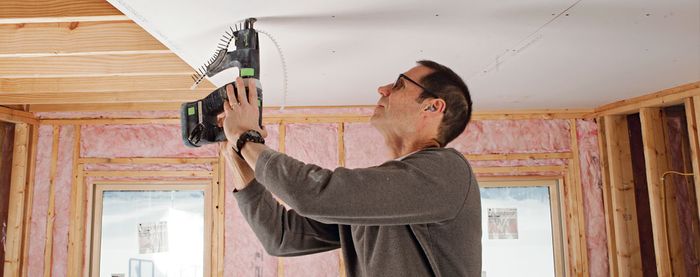
In a room that will have drywall attached to the ceiling as well as to the walls, always attach the ceiling panels first. By hanging the ceiling first, the panels can be cut a little short so that they slip easily into place. The wall panels, installed later, will fit against the ceiling to help support the edges.
Hanging a ceiling—at least without a mechanical panel lift—is a two-person job. And a third set of hands never hurts. I usually use adjustable step-up benches to hang ceilings that are 9 ft. high or less. I know a few drywall hangers who use stilts when attaching drywall. One crew member on the floor does the cutting and hands the panel to two other crew members on stilts. They in turn lift the panel into place on the ceiling and attach it, cut openings for any electrical boxes, and take the next measurement. Under ideal conditions, working on stilts is the fastest way to hang drywall on ceilings, but I don’t usually use them. The two members on stilts can’t cut and carry panels, which means a lot of work for the person on the floor. In addition, the work area must be kept clean and uncluttered to minimize the risk of falls.
Raising a PanelThough the first few boards can be awkward, two people can do efficient work hanging ceilings without a lift. Start with two step-up benches centered under the section to be hung, and be sure to carry fasteners on your belt. 
|
Prevent Sagging Ceilings
- Fur out the ceiling if on-center spacing is not adequate.
- Use a type of drywall more resistant to sagging.
- Control humidity in the structure before the work begins, while it is being done, and after the installation is complete.
- Prime before texturing. And always let the primer dry thoroughly before texturing.
- Hang the drywall perpendicular to framing.
- Avoid attaching drywall over sagging insulation.
My favorite way to hang high ceilings, especially cathedral ceilings up to 15 ft. high, is to use a mechanical panel lift. This tool does the heavy lifting while I position the panel. And once I’ve aligned the panel, the lift holds it in place while I attach it. It makes your work a little easier, and lifts can be rented from many drywall suppliers and home centers.
| WORK SMART: If you’re hanging a cathedral ceiling without a lift, it’s easier to attach the lower panel first and then work your way up to the top. By starting at the bottom, you’ll have an edge for the next panel to rest on while you hang it. This is easier than trying to lift a panel up to fit against the bottom edge of the panel below it. |
Ceiling panels can be hung perpendicular to the joists or parallel to the joists. I prefer to attach the ceiling panels perpendicular to the joists for a number of reasons:
- Ceiling panels are less likely to sag when hung in this direction (see the sidebar “Grain Orientation in Drywall”).
- It allows the butted seams to be attached to a solid nailer for the length of the seam or floated between the joists.
- It is easier to see the joists when fastening the panels.
- It gives the structure greater strength.
- It won’t matter that much (and may not even be noticed) if the on-center spacing of a ceiling joist is off.
- It allows the drywall to float over slightly uneven joists, making them less conspicuous.
The only time I hang drywall parallel to the joists is when doing so avoids creating butted seams on the ceiling, or when the method of application affects the fire rating or structural design. Before opting for this method, though, check the spacing of the joists carefully—they must be spaced so that the edge of each panel falls on the center of a joist. If the tapered edges don’t hit on center, you may have to cut the long edge of the panel, which will create a long butted seam. And take care not to create a seam on a joist that is either crowned up or sagged down, as it will be difficult to hide when taping. Also check to make sure the type of drywall you are using is approved for hanging parallel to the joist with the on-center spacing.
No matter the direction in which the panels are hung, if you cannot avoid butted seams, stagger them and keep them as far away as possible from the center of the ceiling. Discontinuous butted seams are easier to conceal and less likely to crack.
Before hanging drywall, some ceilings are first furred with 1×3s perpendicular to the joists. A ceiling may be furred for a number of reasons: to help straighten out a wavy ceiling, to decrease the distance between the nailers (ceiling joists), or to provide solid nailing over rigid insulation. The 2-1/2-in.-wide strips make an excellent target when fastening the drywall. The strips should be treated just like ceiling joists, and the drywall should be hung following the same procedures.




